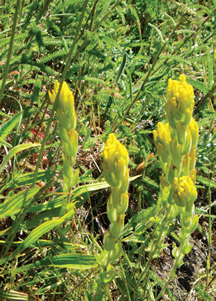Golden paintbrush
| Castilleja levisecta | |
|---|---|
 |
|
| Scientific classification | |
| Kingdom: | Plantae |
| Clade: | Angiosperms |
| Clade: | Eudicots |
| Clade: | Asterids |
| Order: | Lamiales |
| Family: | Orobanchaceae |
| Genus: | Castilleja |
| Species: | C. levisecta |
| Binomial name | |
|
Castilleja levisecta Greenm. |
|
Castilleja levisecta is a rare species of flowering plant in the broomrape family known by the common name golden paintbrush, or golden Indian paintbrush, listed under the Endangered Species Act in 1997. It is native to British Columbia and Washington, where it is known from eleven remaining populations. It occurred in Oregon but all natural occurrences there have been extirpated. It has been reintroduced to a few areas in Oregon, but it remains to be seen if the plants will survive. The plant is a federally listed endangered species of Canada and was listed as threatened in the United States in 1997.
Castilleja levisecta (golden paintbrush) was first collected near Mill Plain, Washington, by Thomas Jefferson Howell in 1880 and was described by Jesse More Greenman in 1898 (Greenman 1898). This is a perennial herb growing in clumps of up to fifteen stems. The leaves are green, containing chlorophyll to undergo photosynthesis, but like other Castilleja it is a hemiparasite, capable of tapping the roots of other plants to obtain nutrients and water. The inflorescence contains bright golden yellow bracts with small green flowers tucked between them. It is the only Castilleja with yellow bracts within its range in the Pacific Northwest. The plant is thought to be pollinated by bumblebees, including Bombus californicus. The species is nearly self-incompatible, and a plant produces many more seeds when crossed with a less closely related individual, such as a plant from a separate population.
This species grows in prairie habitat at low elevations, generally in soils of gravelly, glacier-carved sediment. It often occurs alongside Idaho fescue (Festuca idahoensis) and red fescue (F. rubra), and it is a member of the Garry Oak ecosystem. The remaining Canadian occurrences of the species are on Trial Island and Alpha Islet off of Vancouver Island. There are nine populations in Washington in maritime grasslands and bluffs around the Puget Sound. Most of these are on islands, including several on Whidbey Island and one on San Juan Island.
...
Wikipedia

